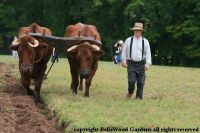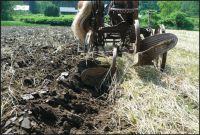Acre
The word acre in English is “a measure of land area, originally as much as a yoke of oxen could plough in a day” (Oxford English Dictionary). The word translated acre in Isaiah is from the Hebrew word meaning “yoke”, because their acre (like ours) was generally defined as the area that one yoke of oxen could plow in one day. What was that area exactly?
Obviously this measurement varies substantially; hardness of the soil, size of oxen, quality of plow, length of day, energy of the farmer – all have an effect on this. But didn’t the Israelites have some standard measurement, which would be the average of all these factors?
Both of our modern measurements for area can be expressed as a square of a given length. A hectare is 100 meters by 100 meters – 10,000 square meters. An acre is 208’ x 208’ (ish), or 43,560 square feet. Which, you’ll recall, was originally based on the area an ox team could plow in one day.
So if you were an Israelite, looking to define an area, what round number would you use? How about a square 100 cubits by 100 cubits? Which, remember, is the exact same as 100 steps by 100 steps!
The math is: 100*25.2” = 2520”/12 = 210 linear feet in 100 cubits. 210’*210’ = 44,100 square feet. So 100 square cubits makes an acre only 1.2% larger than our modern acre! Our acre which was ALSO defined as the area a team of oxen could plow in a day!!
But while our acre is defined as an awkward 208’x208’ (or perhaps worse, 1 furlong by 1 chain!), God’s acre is a round number of cubits that just so happens to be exactly what a team of oxen can plow in a day!
This is great for a farmer, because he just has to count 100 steps per row – 100 cubits per row – then turn around! Plows tend to turn about 12” (half a cubit) with each pass, so the farmer needs to make 200 passes to plow one acre, which is 100 passes in each direction!
Bear in mind that every other cubit (14.4”, 18”, 21.6”, etc) gives a measurement that is SUBSTANTIALLY smaller, and could not possibly line up with the abilities of oxen across the ages! But that’s not all!

